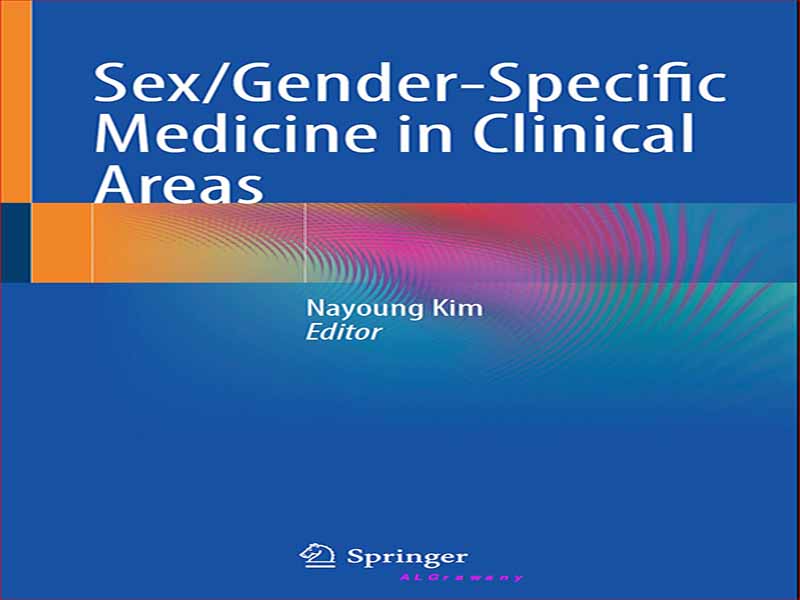- عنوان کتاب: Sex/Gender-Specific Medicine in Clinical Areas
- نویسنده: Nayoung Kim
- حوزه: پزشکی جنسی
- سال انتشار: 2024
- تعداد صفحه: 537
- زبان اصلی: انگلیسی
- نوع فایل: pdf
- حجم فایل: 10.54 مگابایت
در عصر کووید-19، بیش از 50 درصد از جمعیت جهان واکسینه شده اند. با این حال، تعجب کردم که آیا تأثیر واکسیناسیون کووید برای مردان با قد ۱۸۵ سانتیمتر/۱۱۰ کیلوگرم وزن و زنان با ۱۴۵ سانتیمتر بر ۴۰ کیلوگرم به یک اندازه مؤثر است؟ شاید این اثر از نظر فارماکوکینتیک و فارماکودینامیک متفاوت باشد که تحت تأثیر عوامل جنسی مانند آب کل بدن یا ترکیب چربی قرار می گیرد. علاوه بر این، عوارض جانبی پس از واکسیناسیون بسته به جنس/جنس متفاوت گزارش شده است. به عنوان مثال، نرخ آنافیلاکسی واکسیناسیون کووید-19 در زنان 2.85 برابر بیشتر از مردان در کره جنوبی بود که نشان دهنده تفاوت در مکانیسم ایمنی است. در حالی که پزشکان تمایل دارند موافق باشند که کودکان بزرگسالان مینیاتوری نیستند، تعداد کمی تشخیص می دهند که زنان به سادگی کوچکتر از مردان نیستند. تا همین اواخر، زنان و مردان به جز اندام های تناسلی یکسان در نظر گرفته می شدند. در دهههای 1980 و 1990، درک این موضوع که پزشکی بهعنوان یک کل – از جمله تشخیص و درمان بیماریها – مرد محور است، منجر به تمرکز بر سلامت زنان مانند سیستمهای غدد درونریز و تولید مثل شد. با مطالعات جدید درباره تفاوتهای جنسی/جنسیتی در دیابت، بیماریهای قلبی عروقی و زوال عقل، جنسیت/جنس به عنوان یک متغیر بیولوژیکی مهم شناخته شد. اگرچه بسیاری از محققان و پزشکان معتقدند که تفاوتهای جنسی از قبل به خوبی درک شده است، متخصصان خاطرنشان میکنند که حتی در مواردی که زنان و مردان به تعداد مساوی در یک مطالعه گنجانده شدهاند، دادهها اغلب بر اساس جنسیت تجزیه و تحلیل نمیشوند. در نتیجه، مطالعات پزشکی تمایل به ارائه «میانگین» برای هر بیماری دارند – میانگینی که ممکن است به طور دقیق نه زنان یا مردان را توصیف کند. این موضوع بسیار مهم است زیرا مطالعاتی که نتوانستهاند دادهها را بر اساس جنسیت تجزیه و تحلیل کنند، مکانیسمها و درمانهای بیماری خاص را برای زنان، مردان و افراد غیر باینری نادیده میگیرند. این یک ضرر بزرگ برای زمینه تحقیقاتی و همچنین تنظیمات بالینی است. امروزه مشخص شده است که گیرنده های استروژن (ERs) اثرات گسترده ای در سلول های متعدد در سراسر بدن دارند، نه فقط در اندام های تولید مثل. این بدان معنی است که تفاوت بین زنان و مردان در سطح استروژن بر همه انواع سلول های بدن ما فراتر از سیستم تولید مثل تأثیر می گذارد. گیرنده تستوسترون و آندروژن ممکن است مشابه باشند، که تا کنون کمتر متمرکز شده بود. با توجه به این یافته ها، محققان به طور فعال شروع به بررسی شرایطی کردند که در آن بروز بیماری در یک جنس بیشتر است، یا تظاهرات بالینی بین زنان و مردان متفاوت است، حتی در مواردی که بروز بیماری مشابه است. علاوه بر این، اخیراً پزشکان باید توجه بیشتری به افراد غیر دوتایی و افراد لزبین، همجنسگرا، دوجنسگرا، ترنسجندر و دگرباشان یا پرسشگر (LGBTQ+) که نرخ بالاتری از نابرابریهای سلامتی را تجربه میکنند، داشته باشند.
In the era of COVID-19, over 50% of the world’s population has been vaccinated. However, I wondered whether the effect of COVID vaccination is equally effective for a man with 185 cm height/110 kg weight and a woman with 145 cm/40 kg. Maybe the effect will be different in terms of pharmacokinetics and pharmacodynamics, which are affected by sex factors such as total body water or fat composition. In addition, the side effects after vaccination were reported to be different depending on sex/gender. For example, the anaphylaxis rate of COVID-19 vaccination was 2.85 times higher in females than in males in South Korea suggesting the difference in immune mechanism. While physicians tend to agree that children are not miniature adults, few recognize that women are not simply smaller than men. Until recently, women and men had been considered to be the same except for reproductive organs. In the 1980s and 1990s, the realization that medicine as a whole— including the diagnosis and treatment of diseases—is male-centered which led to a focus on women’s health such as endocrine and reproductive systems. With new studies of sex/gender differences in diabetes, cardiovascular diseases, and dementia, sex/gender became recognized as an important biological variable. Although many researchers and clinicians believe that sex differences are already well understood, experts point out that even where females and males are included in a study in equal numbers, data are frequently not analyzed according to sex. As a result, medical studies tend to present an “average” for each disease—an average that may not accurately describe either females or males. This issue is very important because studies that fail to disaggregate and analyze data by sex miss specific disease mechanisms and treatments for women, men, and non-binary people. This is a big loss for the research field as well as clinical settings. Nowadays, it has become clear that estrogen receptors (ERs) have widespread effects in numerous cells throughout the body, not just in reproductive organs. This means that differences between females and males in estrogen levels impact all kinds of cells in our body beyond the reproductive system. The testosterone and androgen receptor might be similar, which had been less focused so far. In light of these findings, researchers began to actively investigate conditions where the disease incidence is higher in one sex, or where clinical manifestation is different between women and men even in cases where the disease incidence is similar. In addition, recently physicians need to pay more attention to non- binary people, and lesbian, gay, bisexual, transgender, and queer or questioning (LGBTQ+) individuals who experience higher rates of health disparities.
این کتاب را میتوانید بصورت رایگان از لینک زیر دانلود نمایید.




































نظرات کاربران